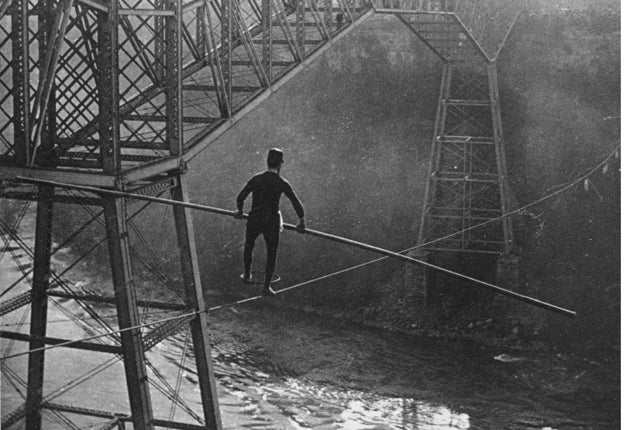It takes a cool head, impeccable balance, and plenty of self-confidence to walk unaided across the Niagara Falls on a tightrope. Unfortunately, for daredevil Nik Wallenda at least, it also requires formal permission from local bureaucrats, whose remit includes the inevitable damper of health and safety.
The 32-year-old circus performer is hoping to become the first person in more than a century to perform the high-wire stunt. He says he wants to revive a noble tradition of derring-do which stretches back to the tourist destination's golden era in Victorian times. But first, he needs one very important rubber stamp.
Lawmakers in New York State voted earlier this month to endorse Wallenda's stunt, hoping it would restore the fortunes of a once-glamorous attraction which has fallen upon hard times. Legislation allowing him to make the first tightrope crossing there since 1910 is supported by the Mayor of Niagara Falls, Ontario, on the Canadian side.
That counts for nothing, however, unless Canada's Niagara Parks Commission approves the project, which will be bankrolled by a film crew from the Discovery Channel. The commission controls the land where one end of Wallenda's 2,200ft tightrope will have to be secured. And at present, they want nothing to do with him.
"There's an existing policy that we don't permit stunting, and tightrope walking falls under the definition of a stunt," said Janice Thompson, the chair of the organisation. "We have the vision of preserving and conserving and celebrating the natural wonder that is Niagara Falls... [This] doesn't seem to us like sustainable tourism. It's not a good direction to be going in."
Wallenda, who is from the seventh generation of a family who have walked tightropes for a living, hopes to convince Ms Thompson otherwise. He argues that despite the 170ft drop which awaits him should he fall, there is more science than stunt to his ambition to cross the Horseshoe Falls section of the landmark.
"A stunt is somebody going over the Falls in a barrel and hoping that they land right," he told reporters. "This is something you can nearly perfect. So to call it a stunt is contrary to everything I've ever done my entire life... Everyone who walks a tightrope is very highly skilled. There's a huge amount of training in what we do."
Behind the scenes, differing attitudes towards Wallenda's proposed stunt highlight a wider debate about the future of the Niagara Falls, which became a tourist attraction in the early 1800s and as recently as half a century ago was considered one of the most glamorous destinations in North America.
Today, the natural beauty of the Falls has been long tarnished by commercialism. On the US side, the local town has an air of genteel decay. The population has halved since 1960, and it now suffers unemployment rates of more than 10 per cent – the highest in New York State. The Canadian side, where there is a ferris wheel and larger hotel-resorts, caters to the package, rather than high end, of the market.
Civic leaders on both sides are exploring new ways to shore up the local economy. Some hope to cash in on New York State's recent legalisation of gay marriage (a rainbow flag was projected on the Falls at the weekend to tout its virtues as a same-sex wedding venue). Others want to recreate the carnival atmosphere which once pervaded the area.
The local tourist board believes that allowing the Falls to be used as a location for televised stunts would give them back a long-lost reputation for pizzazz. "People today still come here and ask questions about the daredevils," a spokesman told the Los Angeles Times this week. "They want to know about their history."
The Falls lie on a river separating Lake Ontario from Lake Erie. The tradition of defying death there stretches back to 1829, when Sam Patch, who is considered the first daredevil in US history, leapt 125 feet from the top of a ladder into the plunge pool below the Falls. A crowd estimated at 7,000 watched the spectacle.
In 1859, Jean-Francois Gravelet, a French circus performer known as "The Great Blondin", became the first man to walk a tightrope across the river below the Falls. He completed the trip on several occasions, once stopping half-way across to cook an omelette.
The more reckless feat of attempting to go over the Falls in a barrel was first attempted in 1901 by Annie Taylor, a 62-year-old schoolteacher. Thanks to a dollop of good fortune, and her insistence that a bicycle pump should be used to increase the air pressure in the vessel, she survived with minor cuts and bruises.
Several copycats weren't so lucky, though. And in an effort to cap the mounting death toll, the Niagara Parks Commission, which had been formed in 1885 to protect the Falls from crass commercialism, voted to outlaw stunts. The last legal tightrope crossing took place in 1910. Since then, dozens of feats have been performed there regardless, some of them fatal.
In 1995, Robert Overcracker achieved fame when he attempted to ride a jet-ski off the Falls, but he died when his parachute failed to open. And in 2003, Kirk Jones from Michigan survived a jump from the top of the Falls wearing only the clothes on his back. But he missed out on a chance to make a fortune when his companion's camcorder failed to record it. Like all contemporary survivors, he was fined several thousand dollars for breaking the law, and banned from Canada for life.

Join our commenting forum
Join thought-provoking conversations, follow other Independent readers and see their replies
Comments